Ever since my parents brought home a pumpkin orange AMC Sportabout (Hornet-based wagon) I’ve had a soft spot for AMC products, and especially their wagons. While not as… interesting… as a Pacer wagon, this Rambler captured my imagination. It’s said to run, but roughly, and it’s not terribly expensive at the moment either, with the no reserve bidding here on eBay at less than $3,000 as I write this.
The 1962 Classics (named as such to differentiate them from the smaller American series) were a development of a 1956 platform, with a 108-inch wheelbase and a very early application of dual-circuit brakes. Push button controls for the automatic transmission were similar to Chrysler’s. The Classic was equipped with one of two 6-cylinder engines although it lost the formerly available optional V-8 , and contemporary road tests were pretty complimentary of the car in general.
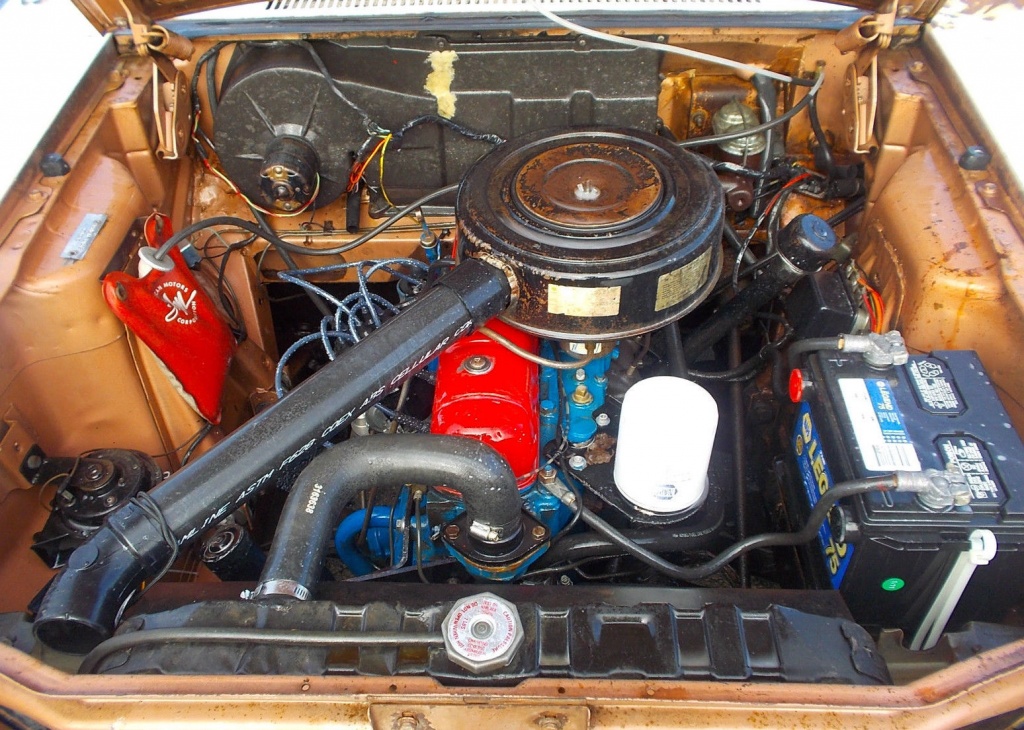
This example has one of the two inline 6’s, despite the ad calling it a V-6. Unfortunately, we don’t know which one it is. One of the available engines was an aluminum block 6 with steel sleeves – I didn’t even know AMC had a 6 like that until researching this article. Interestingly enough, both versions produced ~127 hp, although the aluminum version was 80 pounds lighter! This car has evidently had some work done based on the newish paint on some engine components. I love the oil filter location, and I don’t think I’ve ever seen a longer snorkel on an air cleaner, although the ASTM rating on the side of it is a hint that it didn’t leave the factory that way.
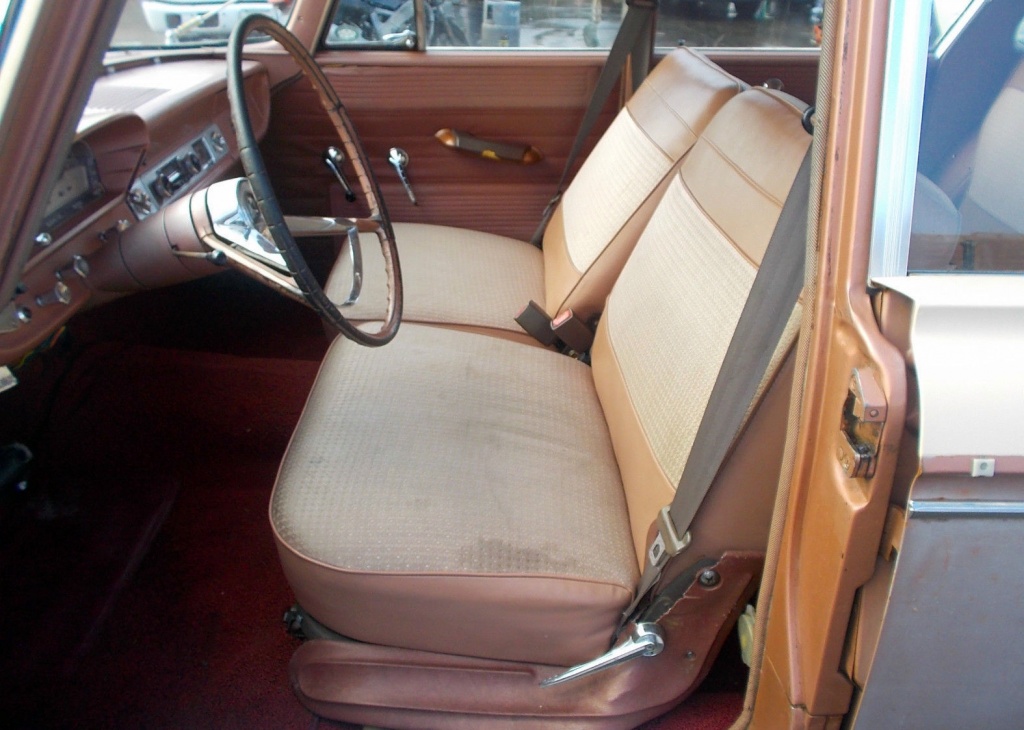
The interior is pretty plain, although I was surprised to see bucket seats rather than a bench. It could certainly benefit from a good cleaning. I don’t know if the upholstery is original, but it certainly looks the part. At least one trim piece is missing, as can be seen by the bare clip on the right of the above picture. I wonder if the stains will come out of the seats? The carpet looks to be in reasonable shape, and certainly wouldn’t need replacing right away. Although the dome light is missing a lens, the headliner looks terrific for its age too. There sure is a lot of usable space in a wagon like this!
The original AM radio is keeping company on the dash with three aftermarket gauges. Although they don’t match the interior, perhaps they are an indicator of a past owner that cared enough to install and monitor them. I’d rather have a previous owner who at least paid attention to critical parameters than one who ignored them.
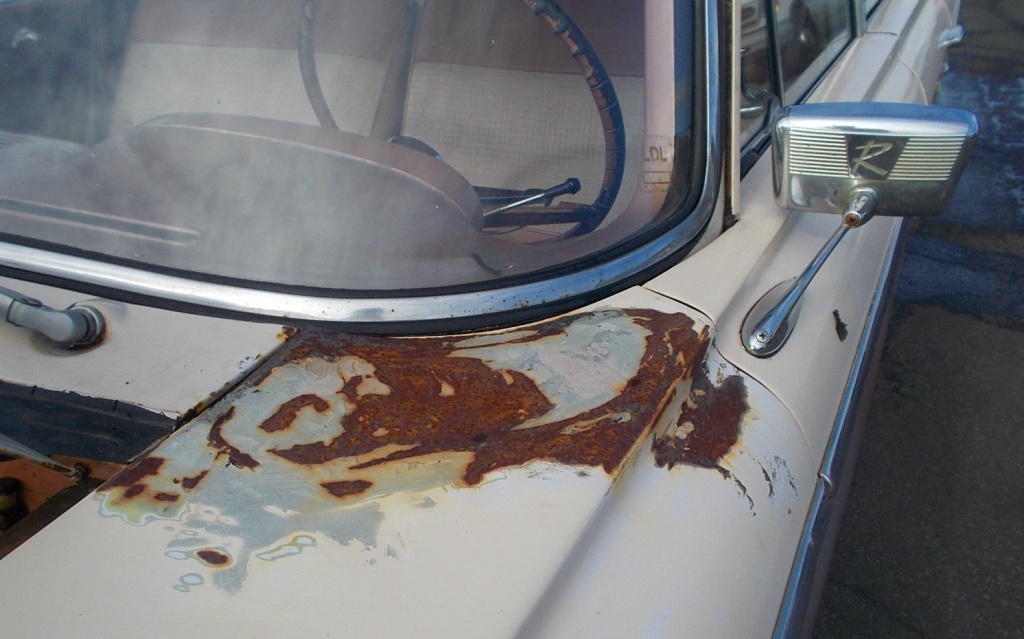
The worst spot of rust on the car is the driver’s side cowl, and while this area certainly requires attention, it’s quite repairable. I absolutely love the “R” embossed in the mirror back. It matches the centers of the dog dish hubcaps too.
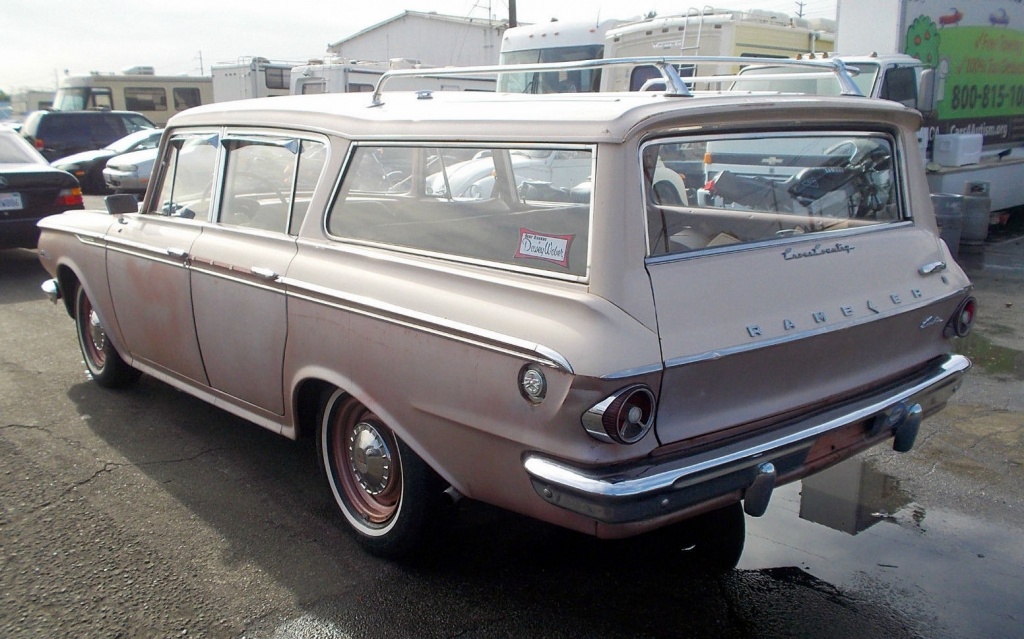
Looking closely at the driver’s side rear window, a decal for Dewey Weber Surfboards is visible. So, would you like to make this your surf wagon?
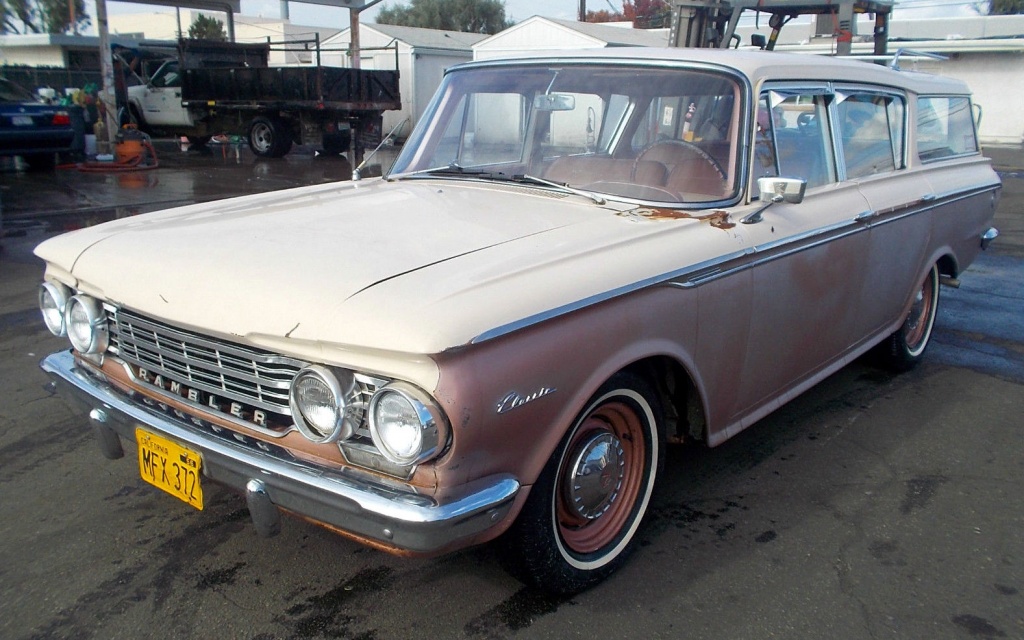

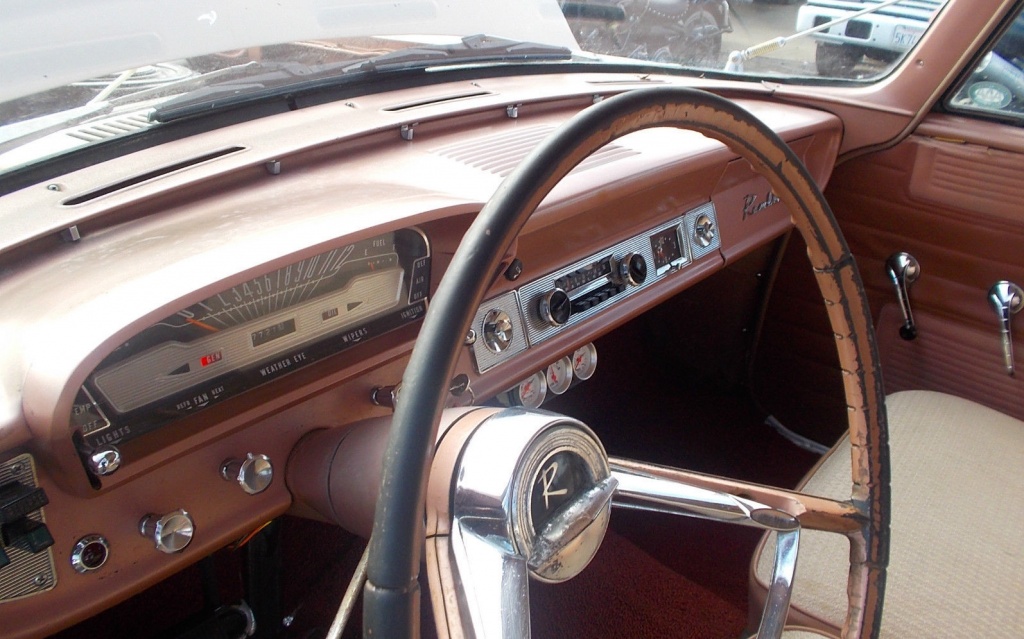


I liked two-tone cars. Even this rather putrid comination might look good if polished and rust free.
The listing says that the seller is a charity (though it doesn’t say which one), and that the car was donated to them…
.. Which means that someone in the right place at the right time could have gotten this car for free.
They’re still out there.
I remember riding in our neighbor’s “new” 2 tone blue Rambler wagon, taking us to go roller skating in Miami. Funny how some memories you just can’t shake. Of course I remember a lot of vehicles from those years.
Did it look something like this. I got this free from a friend who passed away
I’m not sure I’d call the front seat *buckets*, more like a split bench. The air intake tube is funny. It may have been installed to help with a vapor lock issue, or maybe just a kid was the owner?
It is a cool wagon indeed. It’s in Anaheim, which is about an hour’s drive from me. I could just imagine getting this one home and starting “go through” process….but it maybe wishful thinking.
The headliner condition IS amazing as well as the door seals on the body. Huge plus is that it’s pretty much complete. Looking at the door armrests made me think UNOBTANIUM…but then I dont know much restoration of these.
Rust may not be as big a factor as it appears, but then it depends where it is. Bolt on fenders mean that the fenders can be removed and repaired fairly easily with full access to the inside of the panel, or simply replaced. Looks like the cowl panel is also a bolt on piece. Real problems will start if the rust ate into the cowl structural panels below the windshield. Oh, and font forget the roof, doors, etc.As we move past the rust repair, now we need to deal with refinishing repaired areas. Good luck matching the faded 2 TONE color – meaning a complete paint job is in order. Now, we are not going to paint over the dents in the right front door or any wavy area we can see and feel, are we? Complete decent quality paint job – on something like this in 2 tone with blocking the body should start conservatively at $5k but will be more like $7k-$10k. Don’t forget detriming and pulling out glass – did I hear someone say new glass seals? In short, by the time you are done, you could be staring down the barrel of a $15k recon (price of car probably included – the bid just flipped over $3k thresh mark ). Again, not knowing the market on these but looking at similar vintage Detroit greenhouses, I could imagine $15k could get you a near perfect one of these Ramblers… I know, I know – the refreshing process is a great part of fun of ownership but so is driving….
Yes, that’s a split bench to accommodate reclining seat backs, a popular Nash and Rambler feature of the day. Anyone who buys this car take a look at the unibody to make sure it’s not rusted in irreparable ways. Also beware the trunion front suspension system, which is durable IF it’s kept properly lubricated. If it hasn’t been — and a lot weren’t — you’ll be in for some repair bills and a search for parts. These cars are historically important but I must say utterly boring and a pain to drive. The engines are wheezy and sluggish, the steering and handling and ride all depressingly mediocre. They did a job, transporting millions of baby boom-era families, and saved Nash (and its merger partner Hudson) in the process while eliminating those two historic nameplates. But they were the farthest thing imaginable from a fun drive. Just so you know.
No one has mentioned the right hand handle on the rear door, which indicates that this is a seven-passenger wagon with a rearward facing third seat. The standard wagon had a conventional drop down tailgate and a spare tire — the seven passenger was sold with dual chamber Goodyears (I think). Not sure if this was before or after NASCAR adopted dual-chamber racing tires.
The individually adjustable front seats were an option. Standard was a full-width seat, which may have had split backrests.
They were not the only one offering a split bench at the time.
Growing up in northern Colorado in the sixties we always had a rambler classic wagon from 1957 to 1964 models. Dad would get one fix it up and get tired of it and get another one.
We were always going camping in the Rockies in them. One vacation all summer traveled thru 9 states seeing relatives towing an early Colman tent camper. These were the most reliable vehicles I remember as a child. Did my drivers test in a 1964.
The fold down front seats were fun on dates, you could fold down all the seats and make it almost flat inside for sleeping. Great for camping.
Of all of them I do not remember any rust problems then, have seen a lot since then I love going thru wrecking yards but noticed most basically in California were rust free.
I have heard for years rust belt people would buy these and use them for winter vehicles untill they dropped then go find another, good in snow.
Wish I could go get this myself as I’m looking for a second car now in southern Co.
Parts are available.
My parents had one of these. Blue and white paint job. What was really cool was the way the tailgate opened like a door. Can’t remember if it worked that way and down like other station wagons as well.
This Rambler is flat out cool and well worth refurbishing. Blessed with loads of vintage mid century USA funky car character…Uncle Jesse should lose the Volvo wagon immediately and upgrade to this one!
When I was in elementary school, my parents would occasionally have a neighbor take me to school in a Pepto-pink Rambler wagon with a “3 on the tree” due to their work commitments. Even though I was only in elementary school, I fondly recall crouching down in the passenger seat due to the embarrassment of being delivered to my school in, what seemed to me at the time, such an ugly car.
Fast forward forty years, and I’d proudly roll in one of these!
I had a 62 with 3 on the column and “clutchless” shifting….absolute killer in snow…just touch the brakes n the car would do a 180….nearly killed me twice in one snowy drive to Maine in 1970. But an ugly beauty of a car. Love this wagon.
Reminds me of the ’64 that my dad once had.
Not a bad looking old Rambler, but at 3 grand, it’s not a bargain price. Three thousand will still buy you a alot of old Rambler, if your willing to look!
a lot of bids at 50 so far and no reserve. it might make a nice daily driver, but i would not sell a volvo wagon to get this. great find.
Ya, this thing is a little rough, but probably could be a “surf wagon” with little work. That snorkel looks like a chunk of ABS. The seat belts seem to be out of place, too. Kinda like the bland colours. Seem right on a Rambler.
sewer pipe,maybe its methane powered
When I was born, I came home from the hospital in a ’62 Rambler Classic wagon!
AMC/Rambler wasn’t the only one offering a split bench seat, but the only one that I know of offering a RECLINING split bench,,, at least amongst the low to mid price range US built cars.
The rough running is probably due to a leaking head gasket, or worse a cracked head. The 195.6 OHV is derived from the same size L-head (flat-head) six first designed in 1940 as a 172.6 cubic inch engine. The right side casting was changed around the valves, but that was all. Bottom end is the same on the OHV and L-head, just pistons, head, and valve train is different, all other parts interchange. This lead to a different head bolt pattern and the design of head (with intake built-in) makes for a huge lump of cast iron. The head expands.contracts as much as 0.020″ as it heats and cools. Isn’t much, but it’s enough to loosen head bolts over time. AMC recommended checking head bolt torque every 8K miles. With modern gaskets I’ve run 12-14K, but then just retroque the bolts (loosen then torque back down one by one, no need to worry about sequence). Supposed to adjust the valves every 8K or so anyway, so I always adjusted valves and torqued head bolts at the same time. It’s the design (bulk) of the head that causes the issue, not the gasket type. So a modern “no retorque needed” gasket still needs this 10-12K retorque. By “no retorque needed” they mean you don’t run it 500 or so miles then retorque as you had to with 60s era (and prior) head gasket material.
As those heads age and get run hot they tend to crack. The first sign of head bolts getting loose is a leaking head gasket. Most don’t discover this until it leaks bad enough that the engine runs hot. Most of these have been run hot a few times already because people aren’t aware of the importance of retorquing the head until its too late. They are dead-relaible engines as long as that important maintenance step is taken, but without it… Good used heads are hard to find now — the engine went out of production in 1965. The good news is that any 1956-65 iron block head will fit (AMC made an aluminum block version 61-64, it uses a slightly different head — a bit wider and a different head bolt pattern). Hopefully this one wasn’t run hot enough to crack the head, but the rough running does concern me — that could be it.
On the bright side this is the big Rambler and almost any drivetrain will fit, on the downside it has a torque tube driveshaft and axle which must be changed out (and a rear suspension built, someting like a four bar added) to use an open driveshaft drivetrain. The only other engines that will bolt to the existing trans (needed for the torque tube) are 1956-65 196 OHV and 1964-71 199 or 232 AMC six (or 71 only 258). In 72 AMC changed the bell housing bolt pattern of the six to match their V-8m earlier ones have a unique to AMC six bolt pattern.
Wow. I just learned a lot.
Thanks!
As a kid our neighbors drove one of those. I remember riding in it a few times. It did get the job done! If I remember correctly those seats slid forward enough on the tracks for the backs to lay flat and combined with the fold-down rear seat, made a flat area over the entire inside of the car. The neighbors used to camp in their Rambler wagon sleeping the whole family of two adults and three small children. This old wagon looks decent, and should be saved.
I know this is an old post, but I’m posting for the benefit of readers who come across another 1962 Rambler Classic in the future. I have a 1962 Sedan which my late dad bought brand new in Southern California. It’s a Sirocco Beige with the Rose Copper interior like this wagon. The paint code number is 42. My sedan has a 3 speed manual transmission. My rims are Rose Copper. This 2 tone wagon shows the Sirocco Beige with Rose Copper. There were 3 stages of trim on the 62 Ramblers of all models: DeLuxe (no chrome trim, no door jamb light switches and rubber floor mats), Custom (chrome trim on sides, chrome trim across rear, door jamb switches for front doors, interior carpet and weather eye heater), and the 400 (extra chrome strip by taillight on the Classic, full wheel covers and aluminum block 6 cylinder on the Classic). The American came equipped similarly, with the L head engines standard on the and Custom packages, and the cast iron OHV on the 400. The convertible American only came in the 400 package. Many of the Classic Customs came equipped with full wheel covers during the latter part of the production year. Mine is a later 1962 Classic Custom with the full wheel covers and the mandatory factory PCV Valve smog control required to be sold in the Los Angeles, Orange, Riverside, San Bernardino, Imperial and San Diego County areas. The photo of the engine indicates this one was not originally sold in Southern California or Northern California in the San Jose/Oakland/San Francisco/Berkley/Sacramento metropolitan areas. The engine shown is the OHV 196 cast iron 6 with a retrofit home made snorkel done to satisfy smog control retrofits required years ago for 1955-70 used cars being registered in California for the first time or for those undergoing an ownership transfer to a non relative of the vehicle owner.
I noticed the car has a later model dual circuit master cylinder. The original dual circuit master cylinders had screw on caps. I happen to have the original worn out brake master cylinder for my 62 Rambler. A friend of my dad came across an NOS dual circuit master cylinder back in the 80s when the original master cylinder wore out for the second time (my dad rebuilt the original in the late 70s). The 2nd master cylinder in my car matches the original from the factory. The dual circuit brake master cylinder for the 1962 & 63 Rambler was discontinued in the late 1970s to early 80s. The one on the wagon with a clamped cover is from a 64 and later Rambler.